The Apple iPad Review (2012)
by Vivek Gowri & Anand Lal Shimpi on March 28, 2012 3:14 PM ESTGPU Performance
All of our discussions around the new iPad and its silicon thus far have been in the theoretical space. Unfortunately the state of Android/iOS benchmarking is abysmal at best today. Convincing game developers to include useful benchmarks and timedemo modes in their games is seemingly impossible without a suitably large check. I have no doubt this will happen eventually, but today we're left with some great games and no way to benchmark them.
Without suitable game benchmarks, we rely on GLBenchmark quite a bit to help us in evaluating mobile GPU performance. Although even the current most stressful GLBenchmark test (Egypt) is a far cry from what modern Android/iOS games look like, it's the best we've got today.
We'll start out with the synthetic tests, which should show us roughly a 2x increase in performance compared to the iPad 2. Remember the PowerVR SGX 543MP4 simply bundles four SGX 543 cores instead of two. Since we're still on a 45nm LP process, GPU clocks haven't increased so we're looking at a pure doubling of virtually all GPU resources.
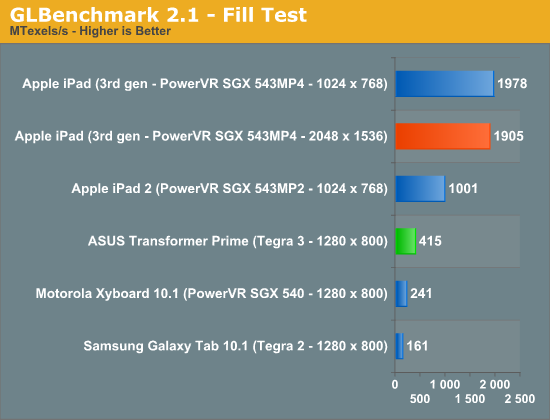
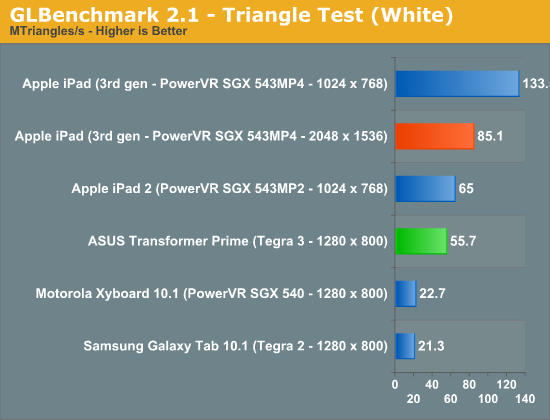
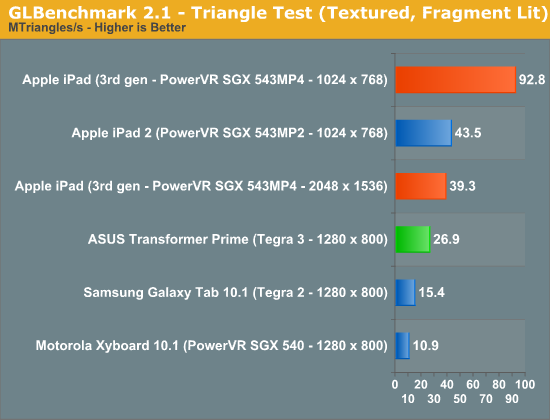
Indeed we see a roughly 2x increase in triangle and fill rates. Below we have the output from GLBenchmark's low level tests. Pay particular attention to how, at 1024 x 768, performance doubles compared to the iPad 2 but at 2048 x 1536 performance can drop to well below what the iPad 2 was able to deliver at 10 x 7. It's because of this drop in performance at the iPad's native resolution that we won't see many (if any at all), visually taxing games run at anywhere near 2048 x 1536.
| GLBenchmark 2.1.3 Low Level Comparison | ||||||
| iPad 2 (10x7) | iPad 3 (10x7) | iPad 3 (20x15) | ASUS TF Prime | |||
| Trigonometric test—vertex weighted |
35 fps
|
60 fps
|
57 fps
|
47 fps
|
||
| Trigonometric test—fragment weighted |
7 fps
|
14 fps
|
4 fps
|
20 fps
|
||
| Trigonometric test—balanced |
5 fps
|
10 fps
|
2 fps
|
9 fps
|
||
| Exponential test—vertex weighted |
59 fps
|
60 fps
|
60 fps
|
41 fps
|
||
| Exponential test—fragment weighted |
25 fps
|
49 fps
|
13 fps
|
18 fps
|
||
| Exponential test—balanced |
19 fps
|
37 fps
|
8 fps
|
7 fps
|
||
| Common test—vertex weighted |
49 fps
|
60 fps
|
60 fps
|
35 fps
|
||
| Common test—fragment weighted |
8 fps
|
16 fps
|
4 fps
|
28 fps
|
||
| Common test—balanced |
6 fps
|
13 fps
|
2 fps
|
12 fps
|
||
| Geometric test—vertex weighted |
57 fps
|
60 fps
|
60 fps
|
27 fps
|
||
| Geometric test—fragment weighted |
12 fps
|
24 fps
|
6 fps
|
20 fps
|
||
| Geometric test—balanced |
9 fps
|
18 fps
|
4 fps
|
9 fps
|
||
| For loop test—vertex weighted |
59 fps
|
60 fps
|
60 fps
|
28 fps
|
||
| For loop test—fragment weighted |
30 fps
|
57 fps
|
16 fps
|
42 fps
|
||
| For loop test—balanced |
22 fps
|
43 fps
|
11 fps
|
15 fps
|
||
| Branching test—vertex weighted |
58 fps
|
60 fps
|
60 fps
|
45 fps
|
||
| Branching test—fragment weighted |
58 fps
|
60 fps
|
30 fps
|
46 fps
|
||
| Branching test—balanced |
22 fps
|
43 fps
|
16 fps
|
16 fps
|
||
| Array test—uniform array access |
59 fps
|
60 fps
|
60 fps
|
60 fps
|
||
| Fill test—Texture Fetch |
1001483136 texels/s
|
1977874688
texels/s |
1904501632
texels/s |
415164192
texels/s |
||
| Triangle test—white |
65039568
triangles/s |
133523176
triangles/s |
85110008
triangles/s |
55729532
triangles/s |
||
| Triangle test—textured |
56129984
triangles/s |
116735856
triangles/s |
71362616
triangles/s |
54023840
triangles/s |
||
| Triangle test—textured, vertex lit |
45314484
triangles/s |
93638456
triangles/s |
46841924
triangles/s |
28916834
triangles/s |
||
| Triangle test—textured, fragment lit |
43527292
triangles/s |
92831152
triangles/s |
39277916
triangles/s |
26935792
triangles/s |
||
GLBenchmark also includes two tests designed to be representative of a workload you could see in an actual 3D game. The older Pro test uses OpenGL ES 1.0 while Egypt is an ES 2.0 test. These tests can either run at the device's native resolution with vsync enabled, or rendered offscreen at 1280 x 720 with vsync disabled. The latter offers us a way to compare GPUs without device screen resolution creating unfair advantages.
Unfortunately there was a bug in the iOS version of GLBenchmark 2.1.2 that resulted in all on-screen benchmarks running at 1024 x 768 rather than the new iPad's native 2048 x 1536 resolution. This is why all of the native GLBenchmark scores from the new iPad are capped at 60 fps. It's not because the new GPU is fast enough to render at speeds above 60 fps at 2048 x 1536, it's because the benchmark is actually showing performance at 1024 x 768. Luckily, GLBenchmark 2.1.3 fixes this problem and delivers results at the new iPad's native screen resolution:

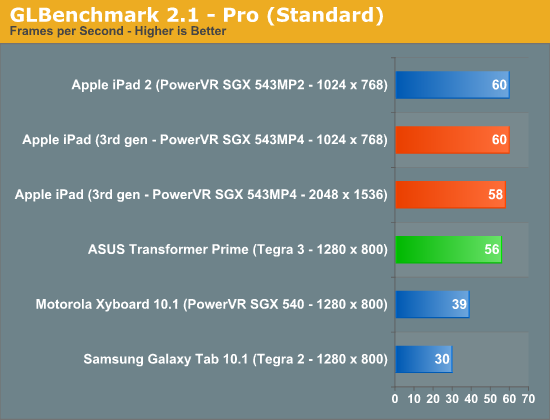
Surprisingly enough, the A5X is actually fast enough to complete these tests at over 50 fps. Perhaps this is more of an indication of how light the Egypt workload has become, as the current crop of Retina Display enhanced 3D titles for the iPad all render offscreen to a non-native resolution due to performance constraints. The bigger takeaway is that with the 543MP4 and a quad-channel LP-DDR2 interface, it is possible to run a 3D game at 2048 x 1536 and deliver playable frame rates. It won't be the prettiest game around, but it's definitely possible.
The offscreen results give us the competitive analysis that we've been looking for. With a ~2x die size advantage, the fact that we're seeing a 2-3x gap in performance here vs. NVIDIA's Tegra 3 isn't surprising:
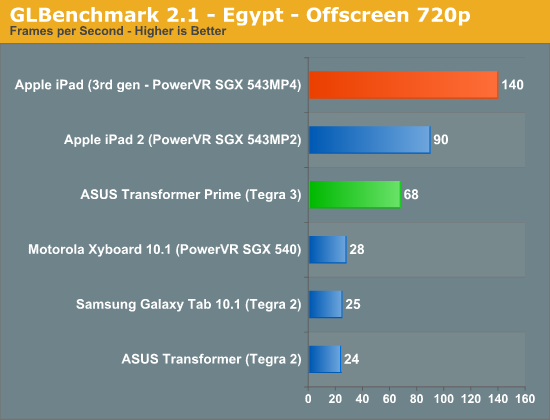
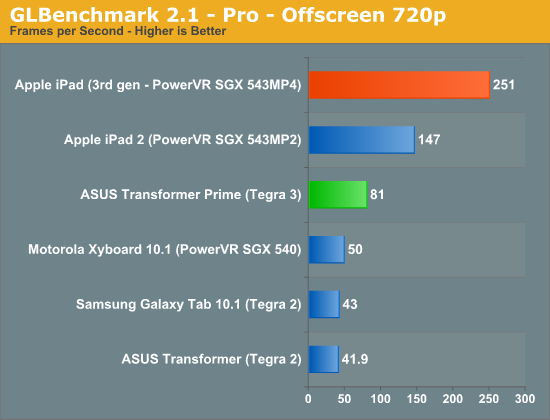
The bigger worry is what happens when the first 1920 x 1200 enabled Tegra 3 tablets start shipping. With (presumably) no additional GPU horsepower or memory bandwidth under the hood, we'll see this gap widen.










234 Comments
View All Comments
vol7ron - Thursday, March 29, 2012 - link
Think you meant "except" :)adityarjun - Friday, March 30, 2012 - link
No, you aren'tsiddharth7 - Friday, March 30, 2012 - link
Yeah! Kind of a typo :). Also forgot the question mark. :-)Wanted to edit it, but was not able to after posting. :)
Xyraxx - Thursday, March 29, 2012 - link
Ok, gaming clearly the TF came out ahead. Why the backhanded commentary in that section? I don't see that for the sections that the iPad clearly won. TF takes the overall top spot for its gaming performance. But instead of commentary on that, we get aggressive talk about how they should be pushing even further ahead, and how they are failing at it.The controller compatibility is an absolute win for the Android side, but instead of talk about that, we get this "Yeah, but who says controllers will win over touch". Its like every advantage the iPad doesn't win over, gets trotted out and downplayed as if to say it doesn't mean anything, or somehow doesn't matter.
darkcrayon - Thursday, March 29, 2012 - link
Interesting. I got a different impression entirely. It seems like games specifically optimized for the Tegra 3 by nVidia were somewhat better visuallyr, but the iPad has a more extensive game library and considering the GPU is far more powerful than the Tegra 3's, it's only a matter of time before there are far better graphics to be had on iPad games.Though there is no OS level controller support in iOS, both Bluetooth and dock connector controllers are possible (hence the iControlpad iCade, and a few others). It may be that more games support them now on Android, but nothing is stopping developers from supporting them on iOS at this point.
Finally, it's pretty important that ~100% of the iPad games in the App Store will run on the new iPad, which can't be said for the TF as shown in the review, or probably for any other individual Android tablet.
mr_ripley - Thursday, March 29, 2012 - link
It seems to me that the iPad does charge when I plug it into the USB port on my Macbook Pro. In fact I was surprised to see that not only did it not say "not charging" and show the "plugged-in" icon, it also seemed pretty fast (I will have to try it again to see if it was as fast as the power charger).However, when I tried to this morning to plug it into my Lenovo laptop it showed "not charging". Does this only work when plugged into Apple products?
vol7ron - Thursday, March 29, 2012 - link
This question seems better suited for the Apple support forums.doobydoo - Sunday, April 1, 2012 - link
This reply seems better suited to the kids-r-us forum.Aenean144 - Thursday, March 29, 2012 - link
Modern Macs have special USB hubs that output 7 to 8 Watts of power (~5V at ~1.6A). Most Windows machines or non-Macs and older Macs output about 4.5 Watts max. There's a USB battery charging specification, but I'm not aware of any computers that have this implemented.So, most Mac should be able to charge an iPod, iPad, iPhone relatively quickly. A PC with the normal USB specs will typically do it a little bit slower. 40 to 50%. 4.5 Watts is basically the bare minimum. Doable on an iPad 2 with the screen off, but the 2012 iPad will be tough. If you have the screen off, turn off WiFi and Bluetooth, it'll charge ok if Apple lets it. The screen has to be off with 4 Watt power source.
mr_ripley - Thursday, March 29, 2012 - link
Ah ha! Thanks for the clarification. When I saw that I was able to charge my new ipad while using it with my Macbook pro USB, I neglected to bring along my charger to work. Seems like that was unwise.But I still have around 50% power left so should be fine for today. And yes I do use it at work.